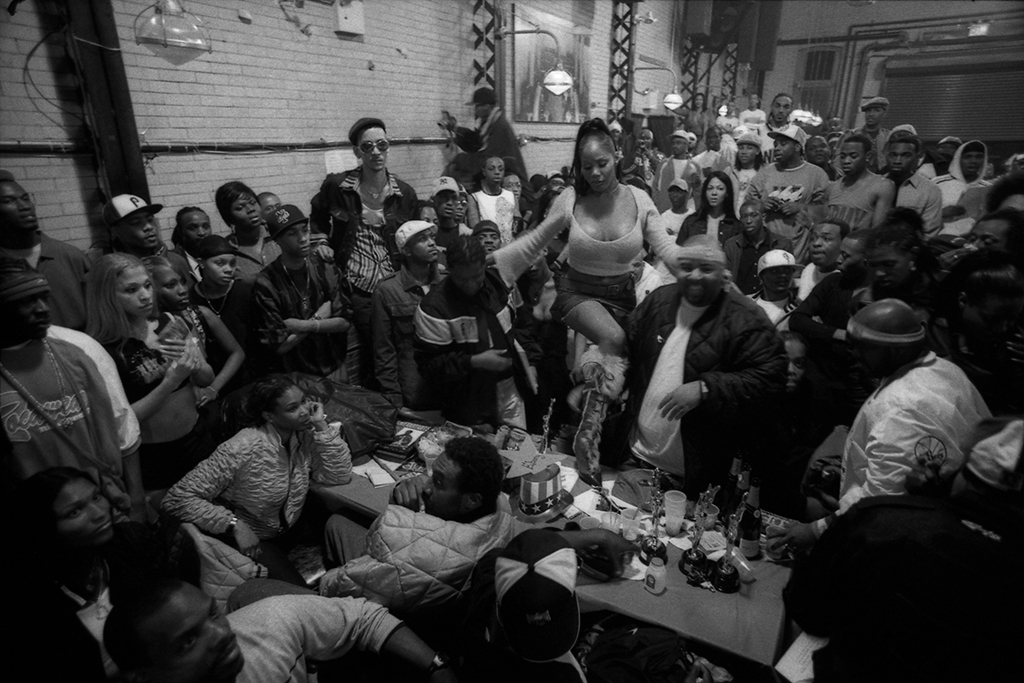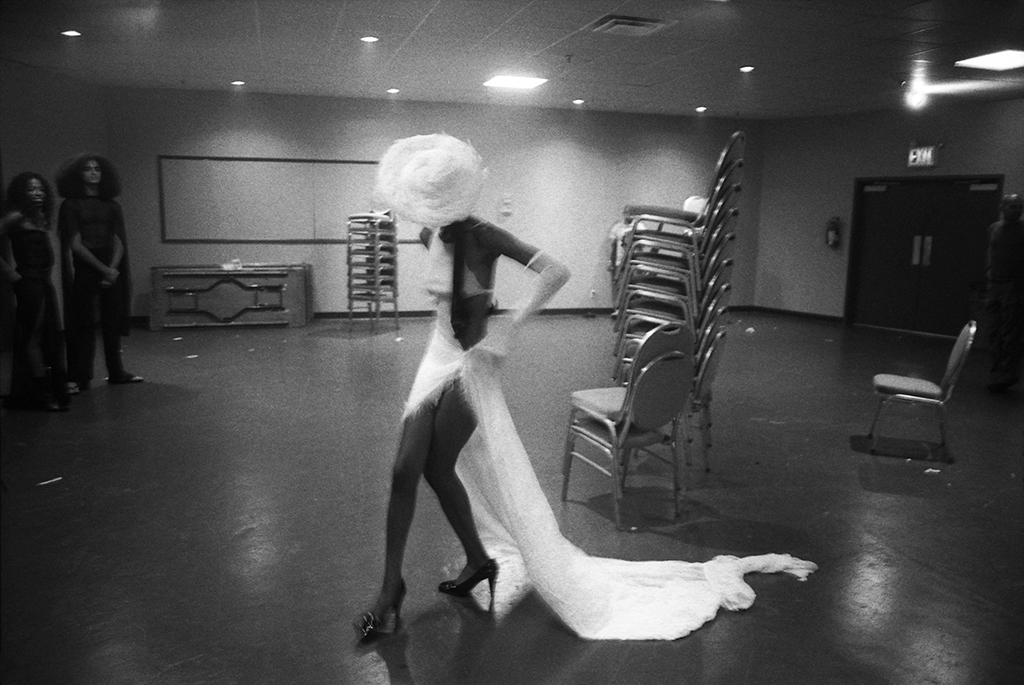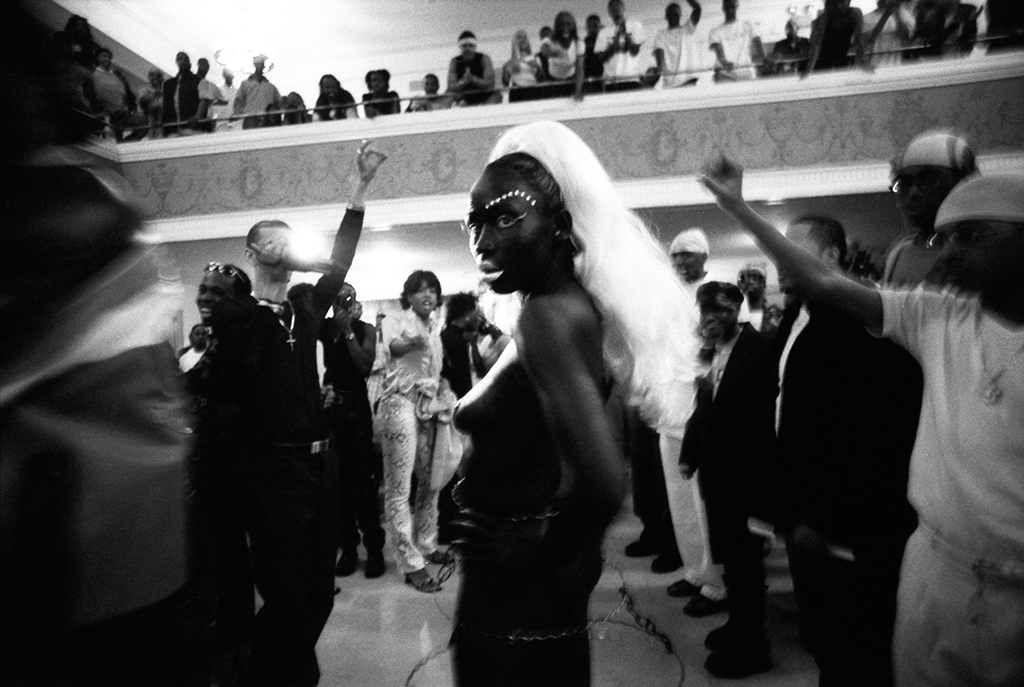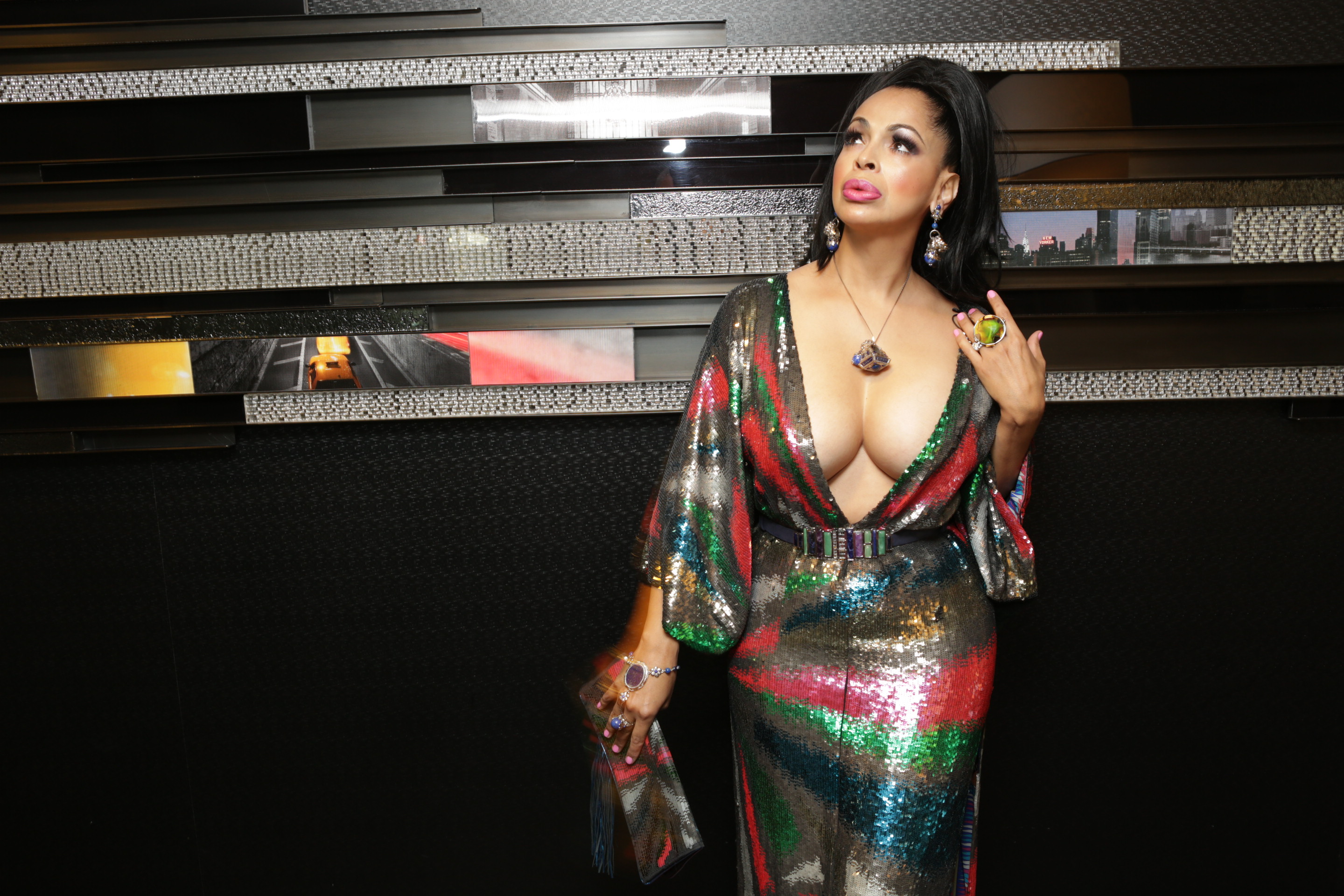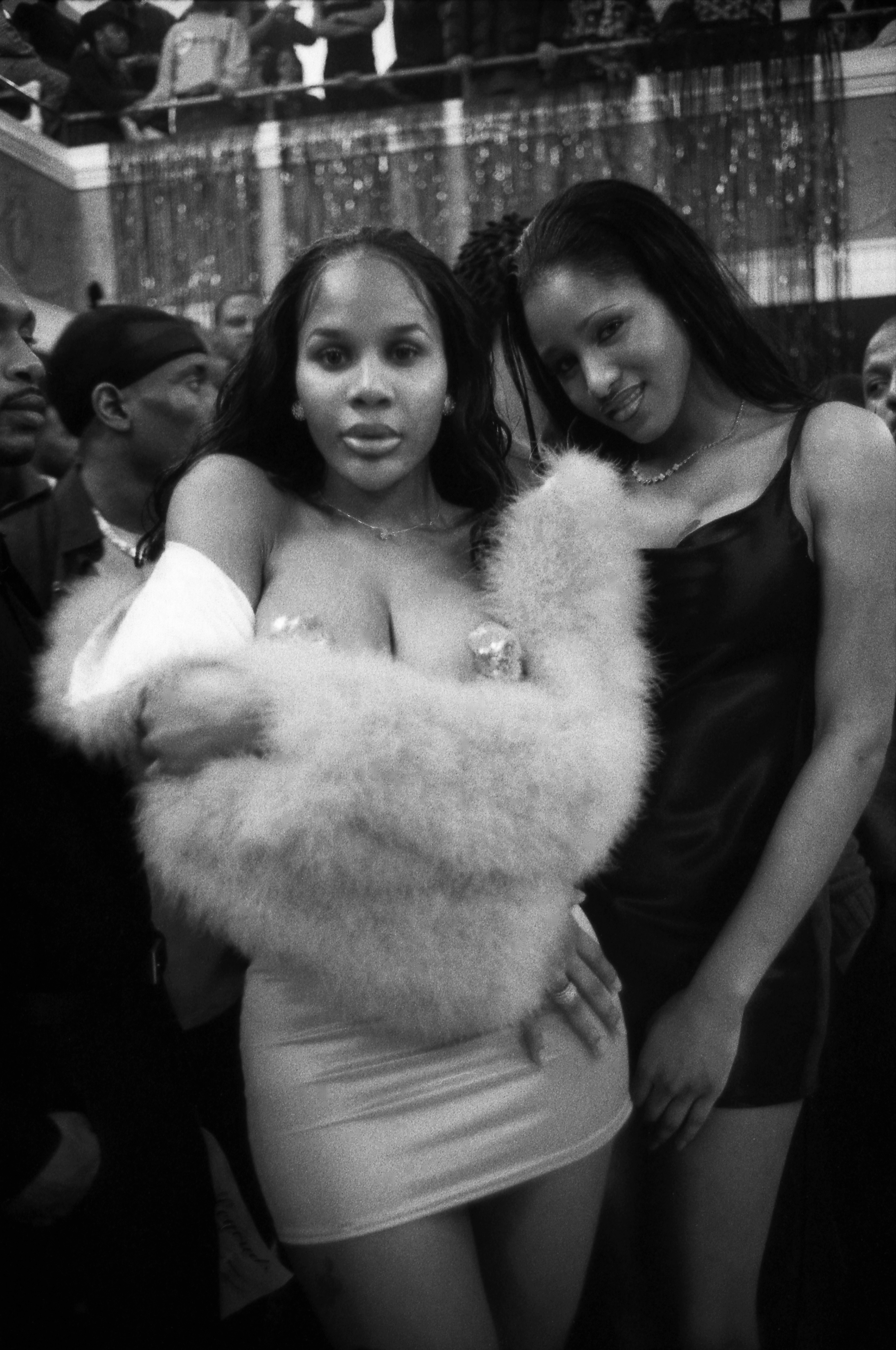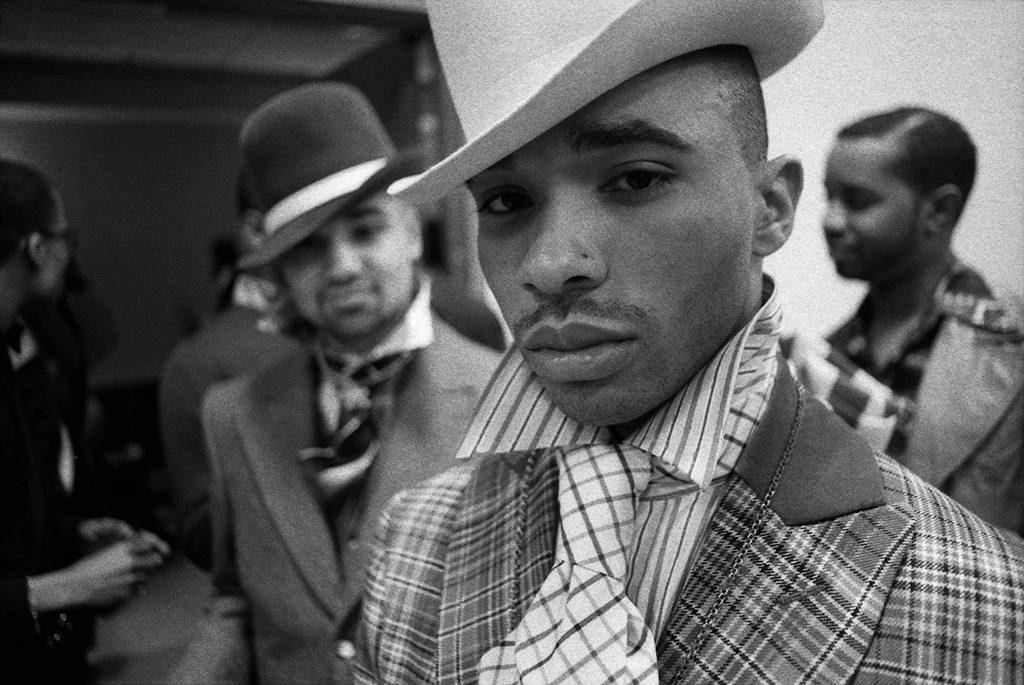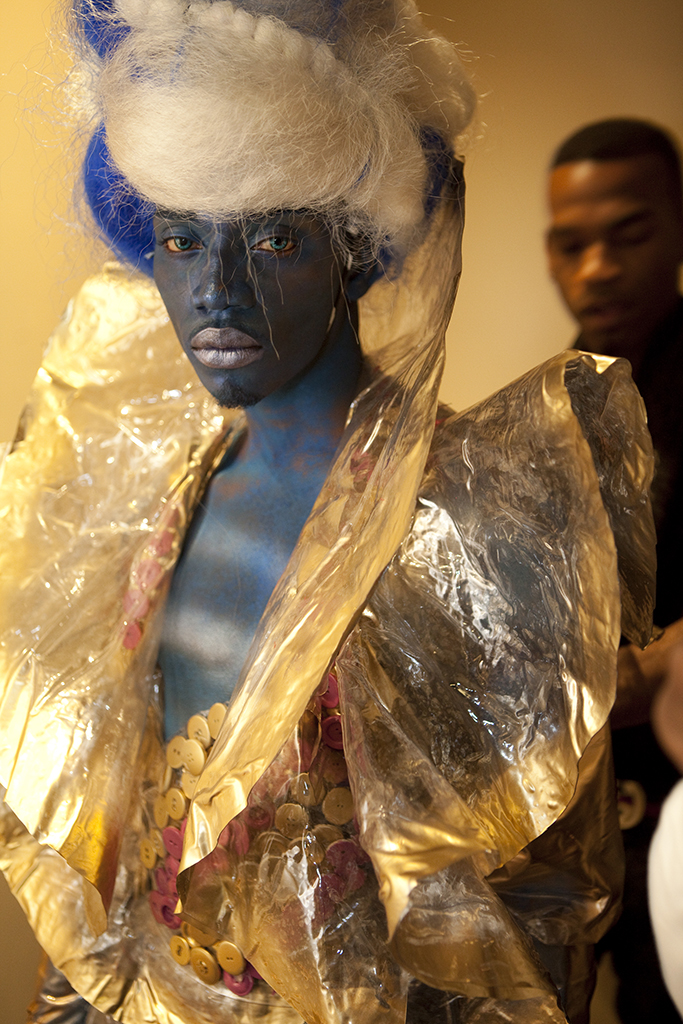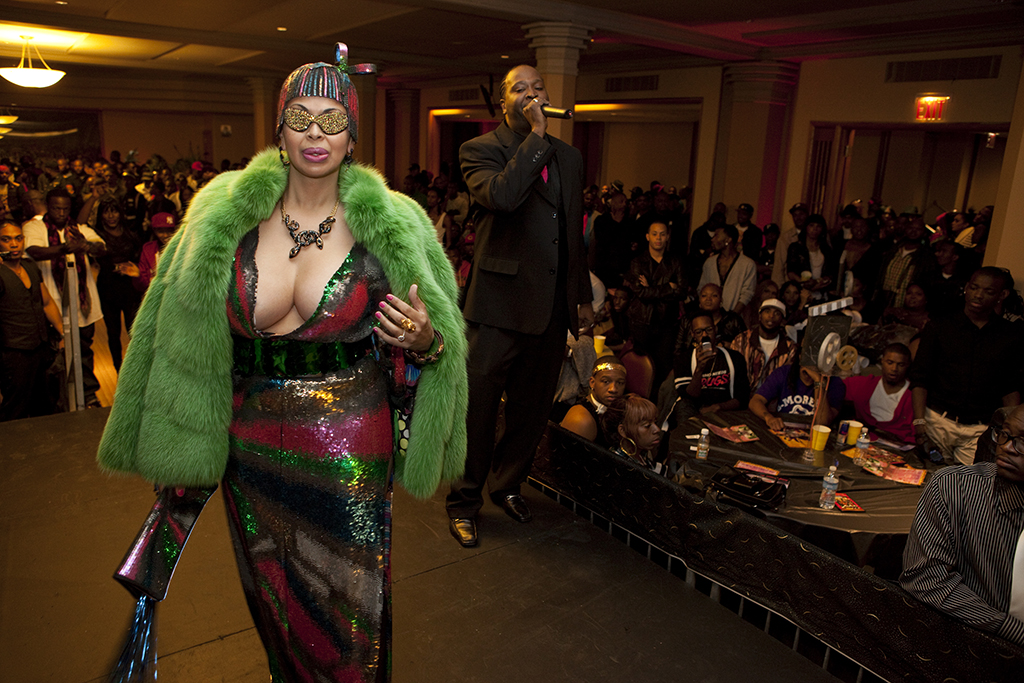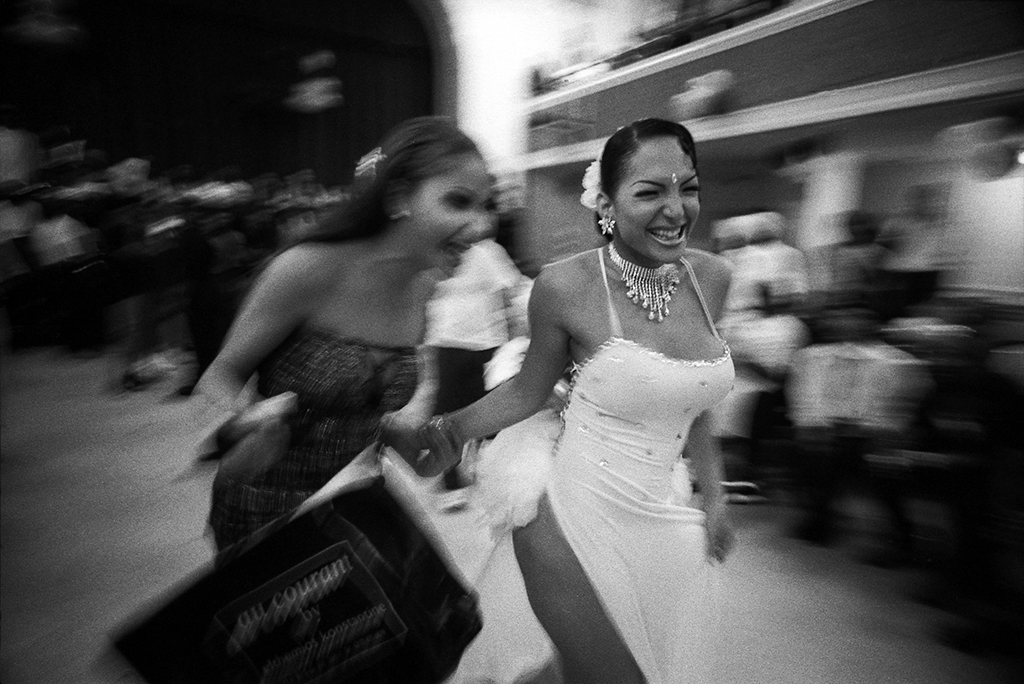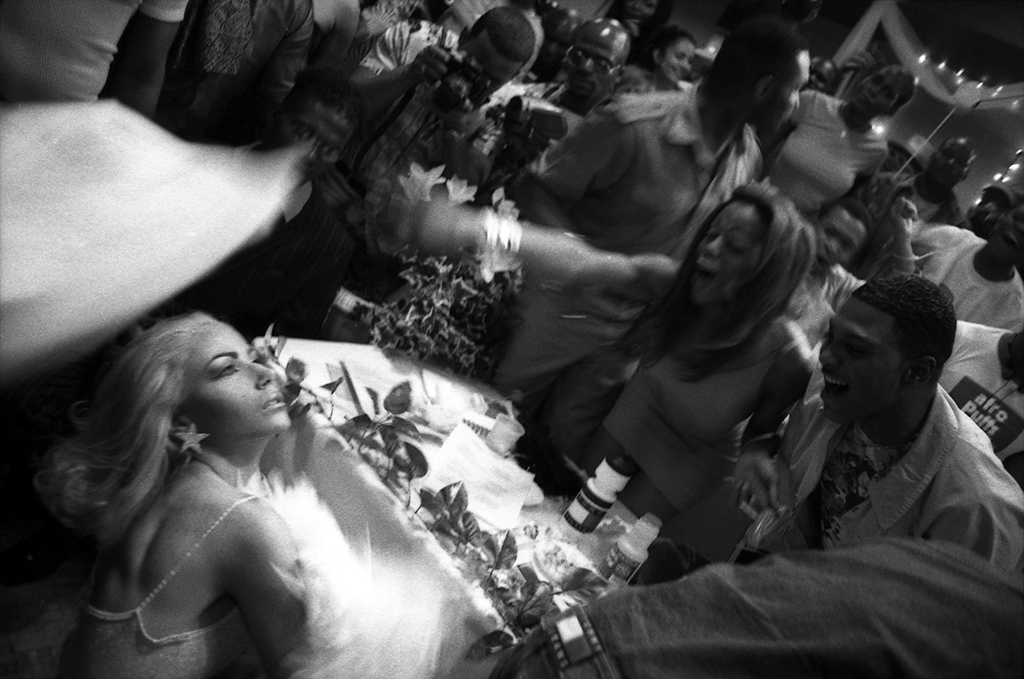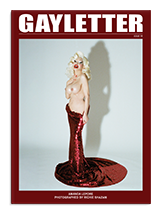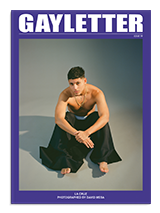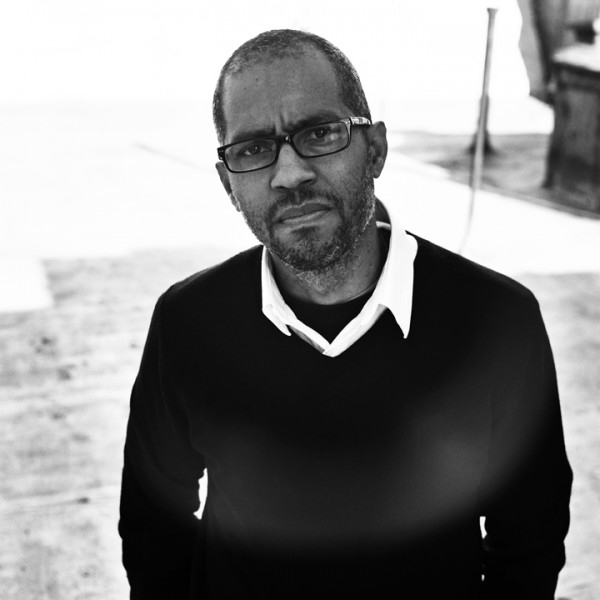
PHOTOGRAPHY BY DANIEL MOSS
Gerard H. Gaskin is Legendary
The photographer discusses his latest book about ball culture
‘Legendary: Inside the Ballroom Scene‘ is Gerard H. Gaskin‘s first book published by Duke University Press. The book is a record of his 20 years going to the balls, it contains black and white and color photographs of vibrant moments inside this scene. Gerard came to New York from Trinidad and Tobago when he was 8-years-old. We chatted to him about his life, the book and his memories of the balls.
You came directly to New York with family? Yes, I came straight to New York. My mom came here, basically worked as an au pair for the first four years for a family in Atlanta, Georgia, and then after that she migrated to New York because her brother and her sister lived in New York. And then four years later we came to New York. Me and my brother and my older sister, I have an older sister actually. My mother passed away and my brother passed away last year, in December.
Oh, really? Around the same time? Exactly. Literally one died on Sunday and the other one died on Tuesday. My mom had ovarian cancer and my brother in some ways kind of flipped out, got drunk, and fell down some stairs on his head. It’s even way more bizarre, because literally I found out I won this prize on Thursday, this happened on Sunday and Tuesday.
What’s the name of the prize? It’s called a First Book Prize. And then I do another project back home in Trinidad, there’s two projects that I’m working on. I do a project on Caribbean identity around cricket, the game, and then I do another project called Trinidadian Artist, where I do portraits of Trinidadian artists. So those are hopefully the next three projects that are in the pipeline.
Why did you call the book ‘Legendary’? It’s interesting, that’s the title that Duke gave. My title was called ‘Walking for Tens,’ and they thought that it was too long, and we then went back and forth with different titles. First it could have been Legends, they came up with really bizarre things that I don’t want to even mention that were so bad that I didn’t really like. The cool thing is I have a really, really small group of ball people who I go to and ask opinions of. There’s the guy who wrote the afterthought in my book, a guy named Frank Roberts. I go to him. There’s a guy named Michael Roberson Garçon, there’s another guy named Derek Ebony. And these guys I went to and I was like, ok, come up with a title for me. And then my friend Douglas, who I told you I met earlier on, he kind of worked to where we got Legendary, and then Duke said cool, I love that, and we’ll have a little byline on the bottom, “Inside the ballroom scene.”
How did you get into photography? I got into photography almost slightly haphazardly. I was a bicycle racer when I was a kid, and when I graduated from high school two of my other friends, really good friends of mine, we went to see the Tour de France in France, and one of those friends had a real camera. When I say a real camera, you know, I had a tiny Instamatic, but he had one of those cameras with a lens and a 35mm or an LSR camera. When I got back from Europe I saw the pictures that he shot at the Tour de France and I was like oh my God, I’d love to get a camera. My mom bought me a camera for my birthday. Then when I started college I took some photography classes. The second photography class I took was with a gentleman named Jules Allen who is my mentor and has been the guy that’s been around for a long time. He’s the guy that kind of, if anything, has molded me into whatever I’ve become.
Where did you take this class? At Queensborough Community College.
I went to Queensborough Community College. He was your mentor? Yeah. And then he told me to then go and study with another really famous photographer at Hunter College called Roy DeCarava. He’s in the same vein as say, Gordon Parks, they’re both around the same age and same era.
What was your introduction to the balls? The balls came about because of a makeup artist and clothes designer named Douglas Says. Douglas Says is from New Jersey and he subbed for another makeup artist; a really famous makeup artist called Choir Fire who at one point was Whitney Houston’s main makeup artist. And I said to him, I want to take some pictures, blah blah blah, and he then introduced me to Douglas. Douglas used to design clothes for the femme queens at the balls back in the day.
Femme queens, who were they?
A femme queen is considered a pre-op transsexual. So, someone like Octavia St. Laurent who was one of the stars of Paris Is Burning would be someone who you consider a femme queen.
So this guy was the go-to guy if you needed a gown. Yeah. If you were looking for a dress or a gown and you didn’t want a mop one, you would go to Douglas. And Douglas then introduced me, we did a whole series of photographs which I called “Douglas’s Girls” that is actually not in the book, but that was the beginning. And there was a femme queen named Danielle Revlon, who’s actually in the book, it’s the photograph of someone in the cab going to a ball. She then introduced me to the balls.
What inspired you to start this project? You went to the balls. You first said to the makeup artist that you wanted to take photos. What inspired you to continue? Being from Trinidad, Trinidad is I call it the land of Carnival, some people might say Brazil, but us Trinidadians, we think Carnival is from Trinidad. We have a huge history of Carnival, my father was a Carnival costume maker and all those kinds of things. So going to the balls for me was almost an extension of Carnival in Trinidad. And when I then started going to the balls it then put another little spin because it was great to then see people deal and play with the idea of gender and sexuality and also then even mock the idea of what realness is and all those kind of things. That’s the stuff that even to the point kept driving me back and back. I love balls. I love when one of the great announcers, like maybe Selvin or Jack Mizrahi, is announcing and they’re kiki-ing up and then it just becomes this huge…
What held your interest for so long? Because this is something you can go and focus on for a couple of months or a couple of years. Why were you so close to the project? There’s two things. I wanted it to be a book, and my professor up at Hunter College, Roy, he always talked about books. He thinks a real statement of a project is a book. I started kind of shopping this book over 10 years ago, and I would then get, “Yeah, we’re interested, this stuff is great, blah blah blah, but if you can raise $25,000, we’ll do your book for you.” Plus I didn’t have $25,000. So in turn I wanted to keep the work current, I also then started doing other photographs. And what would happen in magazines, I would then try to shop it to magazines and they would say, “Ok, we like those pictures but can you do something different?” And then I started doing this whole portrait series and so on and so forth, so that’s the thing that kept me going back. I also think the other part is that the scene always has this really amazing thing that it continues to change all the time, when young and new talent come in they move the scene in different directions. Maybe I’m a sucker for that, but I love watching new talent come and put their own little spin or their own mark on ballroom culture.
What other artists’ work do you admire? There are a few. I think part of this series comes out of, there’s a gentleman named Stanley Greene, and he did a book in Paris called `Paris at Night. I really loved it. He ended up as a war photographer, but he used to be a fine art, documentary photographer. And then I also love Robert Frank, I think he’s a genius. I like that he kept on moving. There are certain photographers who create a certain style and that’s who they are and all they do is that, and they do that for 50 years. Robert Frank started out doing small little camera stuff and now he does Polaroids, film, documentary films. I just love the fact that, here’s a guy who moved and changed and went in all different directions.
You mean he moved with the time. Yeah, and he moved with technique and the quality of work, too. His new stuff, where he’s scratching on negatives, is completely different from the stuff he did in the 50’s and 60’s. So that’s the thing that I really admire.
What do you shoot images with? You use film or digital? 75% of this book is shot film. Black and white film, I usually use Leicas M6 series, I used to have an M4P, that was the first one I ever used. Black and white film.
What film, can I ask? I use HP5 Plus, and then I push it and I push it really, really severely, and then I develop it really, really severely, too. I develop it for 30 minutes.
Are those the ones with the grainy quality? Yeah, it’s grainy, right? When photographers who are real photographers, when I tell them that story they go, 30 minutes?!
Is that a risky thing to do? Very risky.
Have you ever done drag? Oh, dressed up? Actually no. I tried to walk one time.
What category? Runway. Nothing too risque. But of course, getting one foot in front of the other was petrifying enough. I think part of it is because I was just so scared. I was like, oh my God, that kind of thing.
It’s interesting to me. Not that it matters whether you’re gay or straight, whatever it was, but I know you have this body of work that is mainly of people who go to balls: the queer community, trans, crossdressers, DL guys and whatnot. When you show them your book how do they react? I know my straight friends would be like, how did you do it? I think that’s the first question that they ask. And then, you know, I also have gay friends and they’re like oh, wow, even more. It’s interesting, I was really, really attracted to it, you know? In turn, I think very, very early on it was kind of funky for me.
Uncomfortable? Well, I got hit on at the balls, so I had to then get over that thing.
They thought you were doing the business category or something. Yeah, they thought I was trade. I was like no, I’m just here taking pictures. And then they’d be like, well, we’re gonna make you, you know. And then I think it’s interesting when maybe 5 or 6 years after I started photographing the scene, I started getting slightly famous because of the pictures. I would show them, or a magazine would run them. I won a couple of important grants and I was part of a show that was in the Brooklyn Museum, and stuff like that, and people wrote about it and wrote about me. And then I remember one of my really good friends says people are gonna assume that.
That you were gay. That I was gay. And then I think that was the other thing that I had to get comfortable with and accustomed to.
Which is fine. A lot of people assume that people are straight. Right, exactly. That’s exactly it. And like anything else, I think that was the thing that if they didn’t know me and had never met me, then, it didn’t have to be. And that’s fine, there’s nothing wrong with that. But when you’re in the heat of documenting something and you’re really interested in doing it and you wanna do it and you think it’s a great story and it’s a story that needs to be told and stuff like that, all of the other things don’t really matter. You kind of just go for it. And now you have to figure out how you then put your own spin to the idea of what this is. Because I’m not the first photographer who has photographed the balls, and I probably won’t be the last. It’s a great story. It’s a great scene.
Did you become a bigger fan by photographing the balls? How close of a supporter do you think you are to the queer community? Well, I mean I think the first thing is you start developing relationships, you start developing friendships. Now I’ve had friendships with people for 20 years. I was joking last night and I was talking to, I call him the king of ballroom culture, he’s a gentleman named Andre Mizrahi. If you think of the 20 years of me documenting the scene, there are about maybe 10 or 15 people that I think I’ve followed for 10 years, right. I can mention them, it’s Andre, it’s Jack, it’s Selvin, it’s RR, it’s Pagan, it’s Sanaya, it’s Ashley, it’s Alvernian. These people transcend. These are legendary names. And they were my generation, where, say, Pepper LaBeija and Junior LaBeija and Paris Dupree were Jennie Livingston’s group. And then I developed a really good relationship with someone who passed away maybe two or three years ago, a gentleman named Albert Santana who ran the House of Latex and was connected to GMHC. So in turn I then used to do a lot of stuff with him around prevention.
So the House of Latex was related to condoms. What did they do? They’re the ones who brought in prevention and stuff into the ballroom scene. They would then put condoms on the table at a ball and talk to people about being protected and not risky around drugs and safe sex.
Would that house compete? Yeah, yeah, they would compete, too. They would be a house. And Albert was the guy. He would then do all of these committees with the fathers and mothers of the houses and I would go and throw my little two cents into all of these little things.
Since you’ve become more of an insider. You have friends who throw the balls, you have friends who are fathers and mothers. Over time have you seen changes in the structures of the houses? The houses are still structured the same way where there’s a mother and a father. I think now balls have become almost like a global phenomenon. I mean there are young ball kids who are from New York, there’s a really famous one named DeShawn who was part of Vogue Evolution who now goes to France and England and Russia and Sweden and Japan and teaches young girls and boys in these countries how to vogue. So it’s stretched out so much wider now. And now they have houses or affiliations to houses in these other countries. I met a woman last night from Czechoslovakia who was in the House of Ninja…
Benny Ninja brought a demonstration to The LGBT center and he had these two Asian girls vogueing, and it was like ok, they were fierce. Yeah, he’s another one.
Have you met Benny? Yes, definitely.
Who’s the boy on the cover of the book? Why is he on the cover? Is there a backstory? His name is Taz (pictured below). He was walking runway that night. He actually won. It’s funny, I met him for five seconds. I took that picture, I maybe took about five or six pictures of him that night. I saw him, he was backstage, he was getting ready, and this image is taken backstage of him getting ready. And it was boom. And then what happened was the people at Duke really loved it and they picked the image.
What category was he going for? Runway.
What was the last time you went to a ball? I went to the last Latex ball in August.
Do you have to be invited to those balls in order to get in? No, no, if you have money you can come. You pay somewhere between $25 and $30 to get into the ball. Because that’s what it is, it’s also a money venture. What happens is there’s a prize list now, and for some balls the grand prize is like $5,000. So for you to then get that kind of money you have to raise that kind of money.
We’ve been to a couple of balls, even a recent one at PS1, but I don’t think it would be the same experience as going to the ones you are referring to. I know Jack always does mini-balls at Escuelita every Sunday, if I’m not mistaken. And in some ways that would be your best bet to find out where a big ball is happening. Balls now here in New York City are really scarce. There’s now more balls out of state. So in Virginia, in Ohio, in Kentucky and North Carolina and Philadelphia. It’s really, really difficult to get a hall really, really cheap here for the kids to ultimately make money, so that’s why.
Are you satisfied with the outcome of the book? Yeah, yeah. Of course, I wish I had some more pictures in there. My first edit was about 130, and they kind of brought it down to about 94, 92 pictures. There are a couple more, I would say legends. It’s interesting because first you want to take beautiful pictures, but you also want to tell a story and make sure the people who were popular and famous when you were photographing balls are in the book. And there are a few people where it’s like, gosh, I wish this image was in, and stuff like that.
Are you planning any other book projects? Book number two is a portrait-driven project that is the same ballroom scene, but there just portraits. I usually go to the balls and I photograph them with a backdrop and lights and it’s all very staged imagery. I shot it back in around 2001, where I shot 55 polaroids, and now I shoot digitaly. It’s interesting, when I was shopping it, a lot of the photography people were like, this would be a better book. The Polaroid stuff. And I was like, you know, when I won this prize, and because it’s the Center of Documentary Studies, I basically just gave them the documentary-driven images.

